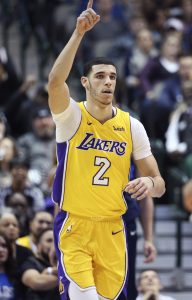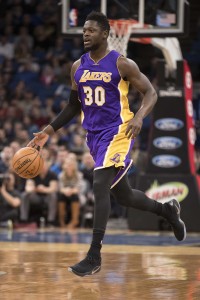No team’s 2018 free agency plans have been discussed more than those of the Lakers, who have long been rumored to be eyeing multiple maximum-salary free agents. Still, for as much as we’ve speculated about the Lakers’ options, there’s some confusion about just how much cap space the team will have at its disposal this July.
One reason for that confusion is simple: There’s a huge variety of scenarios in play for the Lakers, depending on which players or assets they want to keep and which free agents they believe they actually have a legit shot to sign.
It’s safe to assume that the guaranteed contracts of Lonzo Ball, Brandon Ingram, Kyle Kuzma, and Josh Hart will be on the cap for the Lakers next season, barring a trade. Those four salaries total $16,564,080. After that, there are several wild cards to consider when determining the club’s potential cap space.
We’re going to use this space to identify some of those wild cards that will affect L.A.’s cap room projections for 2018/19, detailing the impact that keeping or ditching those players or assets will have on team salary. Let’s dive in…
1. The salary cap itself
The latest cap projections from the NBA pegged the 2018/19 cap at $101MM, but those projections are now nearly six months old. We’ve been using that $101MM figure for informal cap room calculations, but the actual cap may ultimately be lower or higher than that, and even a small change can make a big difference. Just ask the Celtics, who were originally planning for a cap in the $101-102MM range for the summer of 2017, then had to scramble to make room for Gordon Hayward‘s max deal when the cap came in at $99MM instead.
2. Unfilled roster spots
One overlooked detail when calculating a team’s cap room is that clubs with fewer than 12 players under contract must account for cap charges for their unfilled roster spots. Placeholder cap hits equal to the rookie minimum salary are used for those open roster spots. The minimum salary for a rookie in 2018/19 will be about $831K.
So if the Lakers were to pare down their offseason roster to four players, waiving or renouncing all their other players and picks, they’d still have to account for eight rookie minimum slots, totaling nearly $7MM. These cap charges aren’t significant individually, but they can add up quickly if there are a lot of them, and they’ll need to be accounted for.
Cap hit:
- $831,311 per roster slot.
3. Luol Deng
Deng, whose contract is a reminder of the last days of the Mitch Kupchak era in Los Angeles, is perhaps the biggest impediment in the Lakers’ quest for cap room. However, since the team traded Jordan Clarkson and Larry Nance at the deadline, his salary is no longer the roadblock to two max-salary slots that it once was.
Still, the Lakers will have to decide how to address Deng’s contract this summer. The nuclear option would be to trade him and remove his salary from the books entirely, but that would require attaching multiple draft picks and/or young players, and even then it may be hard to find a taker for his $18MM cap hit.
Waiving and stretching the final two years of Deng’s deal would be the simplest option to clear a chunk of cap room. To create even more room, the Lakers could explore Eric Pincus’ idea of giving him a non-guaranteed extension in order to stretch his remaining cap hits over 11 years instead of five, though a move so obviously designed to circumvent standard cap rules may require an OK from the NBA. Keeping Deng on the roster at his current price is also an option if the Lakers strike out on their top targets and roll their cap room over to 2019.
Cap hit:
- If retained: $18,000,000
- If waived and stretched: $7,362,000
- If extended, waived, and stretched: $3,346,364
- If traded: $0
4. Julius Randle
Viewed earlier in the season as an expendable piece if the Lakers land one or two big fish in free agency, Randle has challenged that assumption with his play since entering the starting lineup. Randle has posted monster numbers in his 35 starts, averaging 18.7 PPG, 9.2 RPG, and 3.3 APG with a .581 FG%. To simply let him walk for nothing this summer would be a mismanagement of resources for the Lakers.
Randle will be a restricted free agent, which works to L.A.’s advantage, but even if he doesn’t sign an offer sheet with a rival team early in free agency, his cap hold will be $12,447,727. Keeping that cap hold on their books would cut into the Lakers’ projected space significantly, but I think the team has to do it. If they reach an agreement with Randle that pays him, for instance, $15MM in the first season, the Lakers could wait to finalize that deal and keep his smaller cap hold on the books in the meantime. Once they use up their cap room, they could then go over the cap to lock up Randle.
For what it’s worth, in order to hang onto Randle and their four guaranteed contracts (Ball, Ingram, Kuzma, and Hart) and to create cap room for max-salary slots for LeBron James and Paul George, the Lakers would have to trade Deng — simply waiving and stretching him wouldn’t be enough.
Cap hit:
- If cap hold is retained: $12,447,727
- If renounced: $0
5. Isaiah Thomas
Thomas may not be part of the Lakers’ long-term plans, but he has looked pretty good lately (19.4 PPG, 6.4 APG, .397/.379/.906 shooting in March). If he continues to thrive in Los Angeles during the season’s final four weeks, the team may have to consider bringing him back for 2018/19.
The Lakers will have Thomas’ Bird rights, which would allow them to go over the cap to re-sign him. To hang onto those Bird rights, they’d need to carry a cap charge of nearly $12MM. Will Thomas’ 2018/19 salary exceed that? It will depend on how he looks down the stretch and how healthy he is this summer, but I could see him earning more than $12MM if he finishes strong, especially if he inks a shorter-term deal.
If the Lakers want to hang onto Thomas, one option would be keeping his cap hold on the books, then going over the cap to sign him to a short-term, Kentavious Caldwell-Pope-esque deal. Still, the team will certainly prioritize Randle over Thomas, so if it comes down to those two players, I’d expect Thomas to be renounced first.
Cap hit:
- If cap hold is retained: $11,896,651
- If renounced: $0
6. The non-guaranteed players
Knowing that they wanted to be as flexible as possible in the summer of 2018, the Lakers signed multiple players to contracts with non-guaranteed salaries for 2018/19. Tyler Ennis, Ivica Zubac, and Thomas Bryant all fit that bill. None of those players seems likely to be a major piece of the Lakers’ next championship team. But that doesn’t mean the front office will want to simply give up on them either, especially if the club ends up not needing that little extra bit of cap room for anything.
The decision on Zubac will be the most interesting of the three — according to Basketball Insiders’ data, the Lakers will need to make that call by June 30, before they have a chance to meet with any free agents. Ennis’ and Bryant’s salaries would become guaranteed if they remain on the roster through July 5.
It’s also worth circling back to the second item on our list when considering the impact of these three cap hits. If these three players are waived, they’d likely need to be replaced in the interim by minimum-salary cap hits for open roster spots. So waiving Bryant’s $1,378,242 salary, for instance, wouldn’t clear a full $1,378,242 in cap room — it would just clear the difference between $1,378,242 and $831,311.
Cap hits:
- Ennis
- If retained: $1,656,092
- If waived: $0
- Zubac
- If retained: $1,544,951
- If waived: $0
- Bryant
- If retained: $1,378,242
- If waived: $0
7. The Cavaliers’ first-round pick
The Lakers don’t have their own first-round pick for 2018, but they do own the Cavaliers’ pick. It’s a wild card in multiple ways — not only is there a chance the team could trade the pick rather than keeping it, but it’s also not clear yet where exactly the pick will land in the draft. First-round draft selections carry a cap hold with them, and that hold is larger if the pick is higher.
For example, let’s assume the Cavs go on a hot streak down the stretch and finish with the NBA’s fifth-best record. In that scenario, their pick would be 26th overall and would have a cap hold of $1,689,000, which is 120% of the rookie scale amount for the No. 26 selection. If they slump, it’s entirely plausible they could finish with, say, the 13th-best record in the league, resulting in the 18th overall pick. The cap hold for No. 18 would be $2,337,000.
The situation is something of a catch-22 for the Lakers, who would prefer to get a higher pick, but not if it compromises the team’s ability to squeeze a big contract into its cap room. The range of potential cap holds here is probably within $1MM, so this won’t be a major factor, but it’s still worth monitoring.
Cap hit:
- If pick is No. 18: $2,337,000
- If pick is No. 26: $1,689,000
- Note: For rookie scale figures between Nos. 18 and 26, check out RealGM’s data.
- If pick is traded: $0
When all of these factors impacting the Lakers’ projected cap room are taken into account, the scope of the challenge facing president Magic Johnson and GM Rob Pelinka is clearer. Whether or not the team can land a top free agent or two, it will be a fascinating summer in Los Angeles, with various offseason dates and deadlines giving the Lakers a small window to make major decisions that will shape the franchise for years to come.
Photos courtesy of USA Today Sports Images. Salary information from Basketball Insiders was used in the creation of this post.
They’re just gonna overpay garbage like Tim mozgov and Luol Deng again.
Nothing even close will ever happen again unless Kupchak becomes the GM of the Hornets.
If they could possibly trade Deng and attach that first round pick and maybe a 2nd rounder to help out would be ideal. Keep Lonzo, Hart, Ingram, Randle, Kuzma together. Sign Bryant and Zubac to those league minimums. Sign possibly 1 or 2 max deals and go over to maybe retain guys on Bird Rights. Could be interesting. They can get a solid 7-8 man core group.
Who will take Deng? They’ve already offered him to everyone in the league!
No way Lakers keep it and trying to get James get rid of Pope you have money to get who you need
Forget about LeBron. He’s 33. He’s not going to play with a bunch of teenagers. If Randle stayed, he’d be their oldest player. LeBron probably laughs when he hears the media talking about the Lakers.
Informative and helpful write-up. Thanks for the thorough work, Luke!